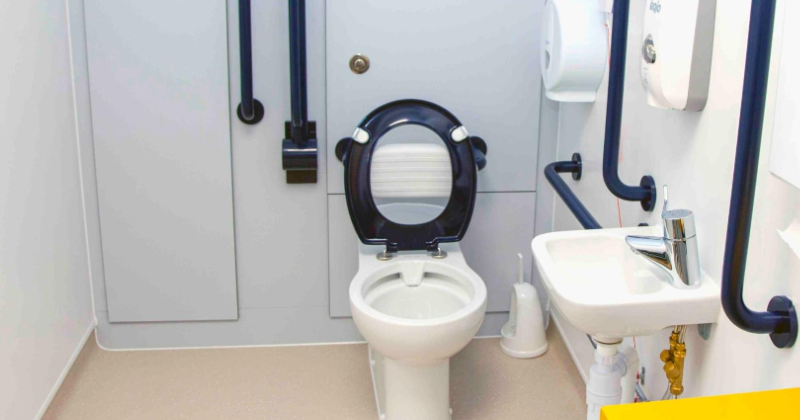Commercial bathrooms should be easy to use for everyone. That includes individuals with disabilities, the elderly, and those with temporary injuries. Making these spaces accessible isn’t just a matter of legal compliance—it’s a matter of basic human dignity. Inclusive restroom design can help people feel seen, safe, and considered.
Whether you’re building from scratch or updating an older facility, this guide walks you through key steps to ensure your commercial bathrooms meet the needs of all users.
Why Accessibility Matters in Commercial Restrooms
People visit public restrooms for the same reason—but their needs aren’t always the same. Imagine navigating a bathroom in a wheelchair, or using one with impaired vision. For many, standard layouts just don’t work.
Accessibility promotes equity. It eliminates unnecessary barriers and gives every user a fair experience. It’s also good for business. Customers and employees appreciate spaces that cater to their well-being. In fact, accessibility can even boost brand loyalty by showing that your company values inclusion.
Understanding Legal Requirements
The Americans with Disabilities Act (ADA) sets specific standards for accessible design. These rules apply to most commercial buildings in the U.S. and include detailed specifications for restrooms. Everything from door widths to faucet controls is outlined.
To avoid penalties or lawsuits, it’s essential to understand the law. For example, at least one accessible toilet stall is required in every public restroom. This stall must include grab bars, sufficient turning space, and a toilet positioned at a compliant height.
The ADA.gov website offers comprehensive guidelines, and consulting a building code expert can help you meet local codes in addition to federal ones.
Layout and Floor Space: Room to Move
An accessible restroom starts with space. Individuals using wheelchairs or walkers need enough room to enter, maneuver, and exit without difficulty.
Here are a few layout essentials:
- Turning radius: At least 60 inches in diameter is needed for wheelchairs to make a 180-degree turn.
- Door clearance: Doors should open easily with lever handles and provide at least 32 inches of clearance.
- Clear pathways: Fixtures and trash cans shouldn’t obstruct movement.
Spacing isn’t just about wheelchairs. Parents with strollers and seniors using canes also benefit from clear, generous layouts.
Fixtures That Serve Everyone
Restroom fixtures play a major role in accessibility. Let’s break down what you need to consider:
Toilets
Toilets must be at a specific height (17 to 19 inches from the floor to the top of the seat) to be ADA-compliant. There should be grab bars mounted on the wall behind and beside the toilet for stability.
You’ll want to ensure your bathroom meets ADA toilet requirements. These guidelines cover everything from seat height to flush control placement, helping make restrooms safer and easier to use.
Sinks and Faucets
Accessible sinks should have knee clearance beneath the counter, insulated pipes, and easy-to-use faucet handles. Lever-style or touchless faucets are ideal.
Mirrors and Dispensers
Mount mirrors with the bottom edge no more than 40 inches from the floor. Soap and towel dispensers should also be within reach, typically no higher than 48 inches.
Urinals
If included, at least one urinal should have a maximum rim height of 17 inches and a clear floor space of 30 by 48 inches in front of it.
Signage and Visual Aids
Proper signage helps users identify accessible facilities with ease. Signs should feature:
- Tactile characters (raised letters or Braille)
- Contrasting colors for visibility
- Universal symbols such as the wheelchair icon
Install signs at the proper height: 48 to 60 inches from the floor. This ensures both standing and seated individuals can read them comfortably.
For users with visual impairments, consider motion-activated voice guidance or floor guides with textured surfaces.
Gender-Neutral and Family Accessibility
Accessibility goes beyond physical disability. Inclusive restrooms should also accommodate caregivers, parents, and individuals of all gender identities.
Family restrooms equipped with changing tables and extra space make a big difference for caregivers. Meanwhile, gender-neutral restrooms reduce discomfort for non-binary individuals or parents assisting children of a different gender.
Providing these options can make your building more welcoming without major construction changes.
Materials and Maintenance: Accessibility in Practice
Designing an accessible restroom is only part of the solution. Keeping it accessible matters just as much.
Avoid high-gloss tiles that can cause glare or slippery surfaces. Install anti-slip flooring instead. Ensure stall doors open and close smoothly, and check that paper dispensers aren’t blocked or empty.
Even a compliant restroom becomes unusable if fixtures are broken, signage is removed, or the grab bars are loose. Train staff to maintain accessibility standards regularly and report issues.
Real-World Examples: Accessibility Done Right
Many large businesses now model excellent inclusive design. For example, Target stores across the U.S. have implemented accessible restrooms with wide entrances, low sinks, and family-friendly features.
Meanwhile, airports such as Hartsfield-Jackson Atlanta International go a step further by offering adult changing stations, a key upgrade that shows leadership in accessibility.
These examples show that with the right planning, accessibility can become a defining strength.
Final Thoughts: Design for Everyone, Not Just for Compliance
Making commercial bathrooms accessible isn’t just a checkbox. It’s a commitment to equity and respect.
By considering layout, fixtures, signage, and maintenance, you create a space that welcomes everyone. And in doing so, you align your business with modern values of inclusion and dignity.
Remember, great design isn’t just about aesthetics—it’s about access. And accessible bathrooms are a simple but powerful way to make public spaces truly public.




